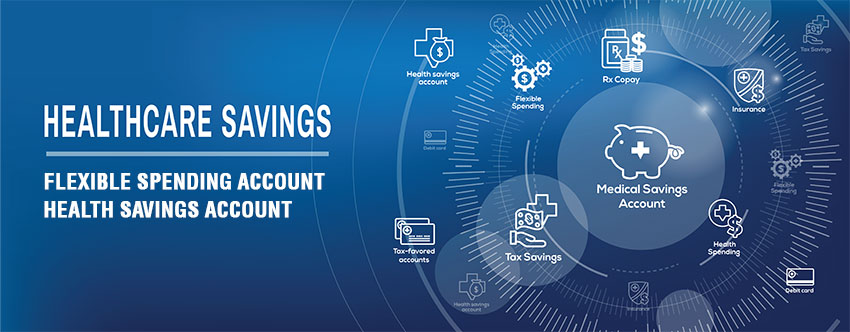How To Get the Most Out of Your FSA or HSA Now and in 2020
Health Savings Accounts and Flexible Spending Accounts can provide big savings to consumers for necessary health costs. These programs make a huge difference for individuals who know what they are likely to spend on their medical needs over the course of a year. However, it also invites the question – how do you determine how much to contribute towards your FSA each year? The answer is specific to every individual, but knowing what items and services are covered by your FSA or HSA can help guide the decision-making process. Most people know they can use their funds on co-pays and prescription medication; but there are a lot of other qualifying items that you may not be aware of, which could help support your annual health goals. Whether you’re trying to use your remaining funds from 2019 or deciding how much to contribute in 2020, you may find the list below beneficial.

Big Ticket Items that Qualify:
Home Defibrillator – Peace of mind is a priceless commodity. If you have severe heart disease, you may be at risk for sudden cardiac arrest, and an automated external defibrillator (AED) can be lifesaving. It’s important to do your research and complete all necessary training and instruction before using.
H-Wave Electrotherapy – A prescription medical device for pain control and rehabilitation. Its portable design allows for at-home use or treatment wherever/whenever you need it. This FDA-cleared device is used to speed recovery, restore function, and manage chronic, acute or post-operative pain. Many H-Wave users experience a decrease or elimination of pain medication, and a significant increase in functional mobility and/or range of motion. H-Wave is often mistakenly confused with another type of electrotherapy: Transcutaneous Electrical Nerve Stimulator (TENS). However, TENS can only temporarily mask pain and is not rehabilitative; whereas H‑Wave provides more effective pain control long after the device is turned off and cumulative, long-lasting rehabilitative benefits. H-Wave also offers an FDA-cleared non-prescription device called the H-Wave OTC.
Breast Pump – Private insurance often only covers specific models, however new technology has allowed for more compact, portable pumps. You can use your HSA or FSA funds to choose the one that best fits your lifestyle.
Baby Breathing Monitor – If you are prone to anxiety over your baby’s health or have a high-risk little one, a baby movement monitor may be a great way to help calm your fears.
Allergy Testing – Aside from standard allergy testing to prevent anaphylaxis or other severe complications, many people have recently opted to test for food allergies as well. Although not necessarily life-threatening, food allergies can cause many unwanted symptoms which can cost a lot to treat. Knowing what changes you can make to your diet by avoiding food allergies can help reduce on-going costs, and have a positive impact on your overall health.
Acupuncture – With self-care trending upward for 2020, you may consider a minimally-invasive service that is said to reduce stress and tension.
Glasses – You will need a prescription from your clinician in order to use your FSA or HSA funds, however it can be very helpful to pay for any portion not covered by your main insurance.
Life Alert – You may consider an item like this for a loved-one; providing independence for them and assurance for you.
Treadmill – This may be one of the most surprising qualifying items. However, home exercise equipment and health club memberships can only qualify with a Letter of Medical Necessity (LMN) from your physician.

Small Ticket Items that Qualify:
Sunscreen – Depending on your sun-sensitivity, this could help you save a significant amount of money on recurring costs of replenishing this everyday commodity (not to mention help prevent future costs of treating skin damage).
Chap Stick – A useful everyday item to purchase with remaining funds at the end of the year.
Electrotherapy Electrodes – If you invest in an H-Wave, you will be happy to find out that replacement electrodes are also a qualifying item, so you can ensure you are always ready to treat throughout the year.
KT Tape – If you’re currently in physical therapy, you may be using KT Tape under a therapist’s guidance and benefit from purchasing some to use at home.
First Aid Kit – If you don’t already have a first-aid kit at home, this is a smart purchase to make sure you are prepared.
Batteries for Medical Devices – Your funds can be used to purchase replacement batteries for important medical devices such as hearing aids.
Bus Fare for Medical Treatment or Services – Keeping track of your cost for transportation to and from appointments can provide a notable reimbursement.
Many people choose to enroll in an HSA or FSA program because they know that investing in their health can be extremely rewarding in the long-run. Excellent health is a huge contributor to quality of life, and it can be very liberating to have a dedicated savings account for these types of purchases. Before deciding on your contribution for 2020, it is important to do your research. The more prepared you are, the better you will be able to customize and maximize your benefit from these programs.
*Please note: not all FSA or HSA programs are alike. It’s important to verify with your specific plan as to which items qualify for coverage or reimbursement.
You may also like: